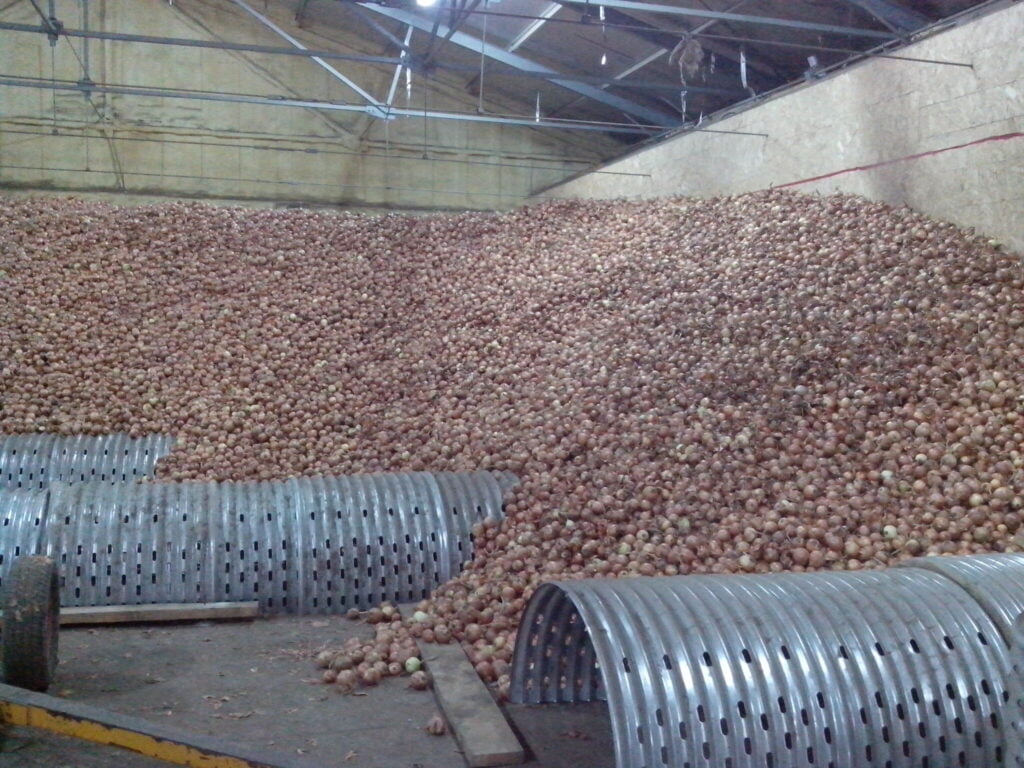Storage facilities for fruits and vegetables consume a lot of electricity. Today, their work has become much more difficult. However, there is a way out even during periods of planned blackouts. The main thing is the reasonable management of the technological equipment of storage facilities, says Andriy Marushchak, commercial director of Van Dyke Technics. The expert spoke about this during the conference “Vegetables and Fruits of Ukraine-2022”, organized by the APK-inform: Vegetables and Fruits project, writes SEEDS.
 “No one was not ready for this, but we had done some work before. We are given schedules (power cuts – ed.), but they do not always work. Storages are different and the features of their use are different, too. For example, the situation for the storage of onions and potatoes is much better than for anything else. Thanks to our energy-efficient equipment, there is quite a small power, and you can get by with a generator twice, thrice a day for 1-2 hours. As our customers say: “We monitor CO2, humidity, and temperature. If there is a fluctuation, we turn on the generators.” Mostly these are generators of 5 – 15 kilowatts. In a small room, when used two or three times a day, they give a good effect. This is not the best solution, but it works much better than being without electricity at all,” – Andriy Marushchak tells.
“No one was not ready for this, but we had done some work before. We are given schedules (power cuts – ed.), but they do not always work. Storages are different and the features of their use are different, too. For example, the situation for the storage of onions and potatoes is much better than for anything else. Thanks to our energy-efficient equipment, there is quite a small power, and you can get by with a generator twice, thrice a day for 1-2 hours. As our customers say: “We monitor CO2, humidity, and temperature. If there is a fluctuation, we turn on the generators.” Mostly these are generators of 5 – 15 kilowatts. In a small room, when used two or three times a day, they give a good effect. This is not the best solution, but it works much better than being without electricity at all,” – Andriy Marushchak tells.
According to the expert, it is more stable in regions where electricity is switched off according to the schedule. A special software element that all storages are equipped with can help in this case.

“If you know the schedules and they work, you can set a schedule for the operation of the equipment, ensuring switching on at a time when there is electricity. These are the simplest settings. Such technologies are mostly used in onion and potato vegetable storage. Also, an emergency closing damper system is provided in storages for the last 12 years, which can be installed additionally as an option and some customers have chosen it. Although we didn’t have such power outages before, if the storage facilities are in the fields and the products are left there, say, for the New Year holidays, which is about 2-3 weeks, there is a risk that the electricity may disappear. And if the dampers remain open, frost can damage the products,” the commercial director of Van Dyke Technics notes.
As Andriy Marushchak said, some of the company’s customers have uninterruptible power supplies. Their power is enough to ensure that the dampers close. Then the storage waits for the power to turn on and the process is restored.
Those farmers who had doubts about a constant supply of energy and took care of a potential solution to this problem before the invasion, suffer less from power outages now.
“If we talk about storage facilities for berries and vegetables, we have customers who expected that they might not have electricity for a long time or equipment or copper pipes might be damaged. They asked us for individual systems for each storage, cooling, sorting, and shipping room. The current situation has shown that this is fully justified. If you have one storage room and it consumes about 10 kilowatts, a 10-kilowatt generator is suitable,” says Andriy Marushchak.
Most customers chose a centralized cooling system because of the difference in cost of 10-20%. A 70-100 kW generator is needed for the system, and this is quite expensive. For example, if you have one storage room and an individual system, you can only install a small 5-15 kW generator on it and do it at a low cost.
In addition, Van Dyke Technics has developed a software package for fruit and vegetable storage that is effective in the current circumstances.
“We are using a rather interesting solution. It is a software package that we have developed and are testing today. If you have 10 storage rooms, but only have enough power for one, the system automatically monitors the load and turns off equipment that can put additional load on the generator. Conventionally, if you have 10 cameras with 10 kilowatts each, and a generator with 20 kilowatts, you can use two cameras. The system automatically monitors and adjusts. Therefore, there are solutions, although they are all temporary and cannot be effective indefinitely,” notes Andriy Marushchak.
The use of the site materials is free if there is a direct and open for search engines hyperlink to a specific publication of the East-Fruit.com website.




